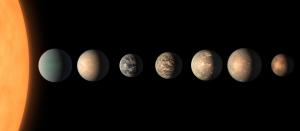Spitzer Space Telescope [1]
The full Moon is passing through Aquarius tonight. The constellation is home to one of the most interesting planetary systems yet discovered. Known as Trappist-1, it contains at least seven planets. All of them are roughly as big as Earth, and three of them are in the “habitable zone” — the distance from the star where temperatures are just right for liquid water.
Most of the system’s planets were discovered or confirmed by Spitzer Space Telescope, which was launched 15 years ago today. It observes the sky at infrared wavelengths, which are invisible to the human eye.
Infrared is produced by objects that are relatively cool. That includes clouds of gas and dust, and the nurseries that give birth to stars.
It also includes planetary systems. When Spitzer was built, the study of exoplanets was in its infancy, so they weren’t even on its list of targets. It turns out, though, that the telescope is good at finding and studying planets in other star systems. In addition to discovering some of the planets of Trappist-1, for example, it found that several of them contain a lot of water.
Spitzer is still operating, but the job is getting harder. It long ago used up the liquid helium that cools its instruments, so some of them have shut down. And it’s moving farther from Earth, which complicates its operations. Still, it’s been approved to continue watching the skies into next year — giving it time to study many more planets.
Script by Damond Benningfield

